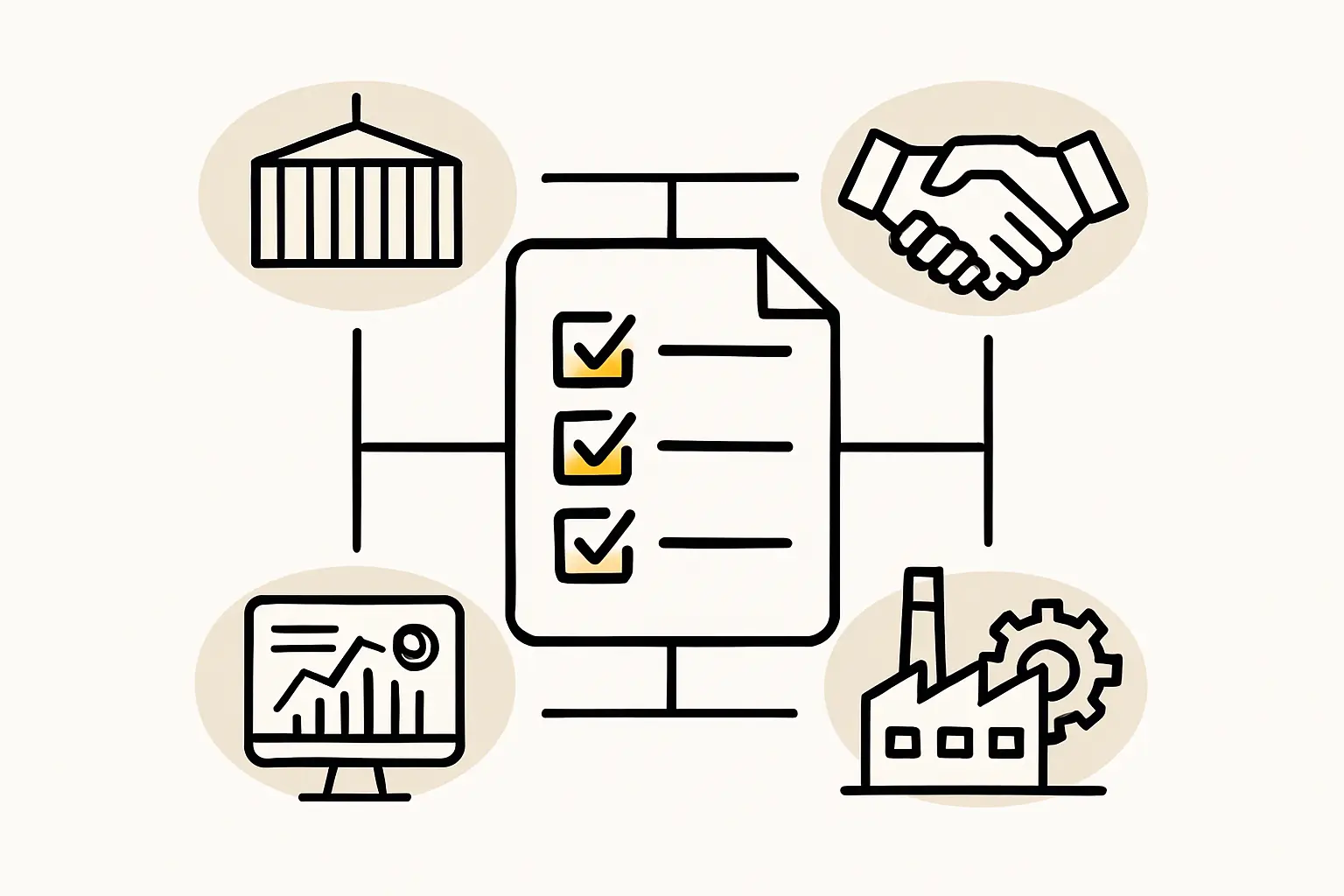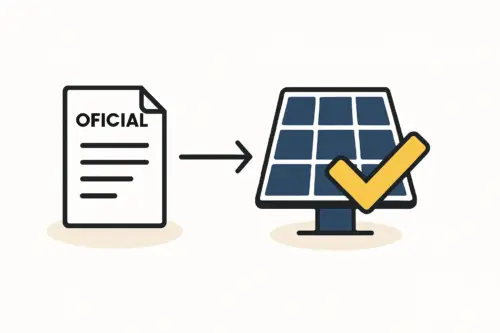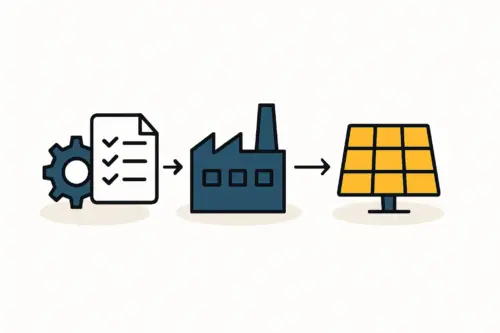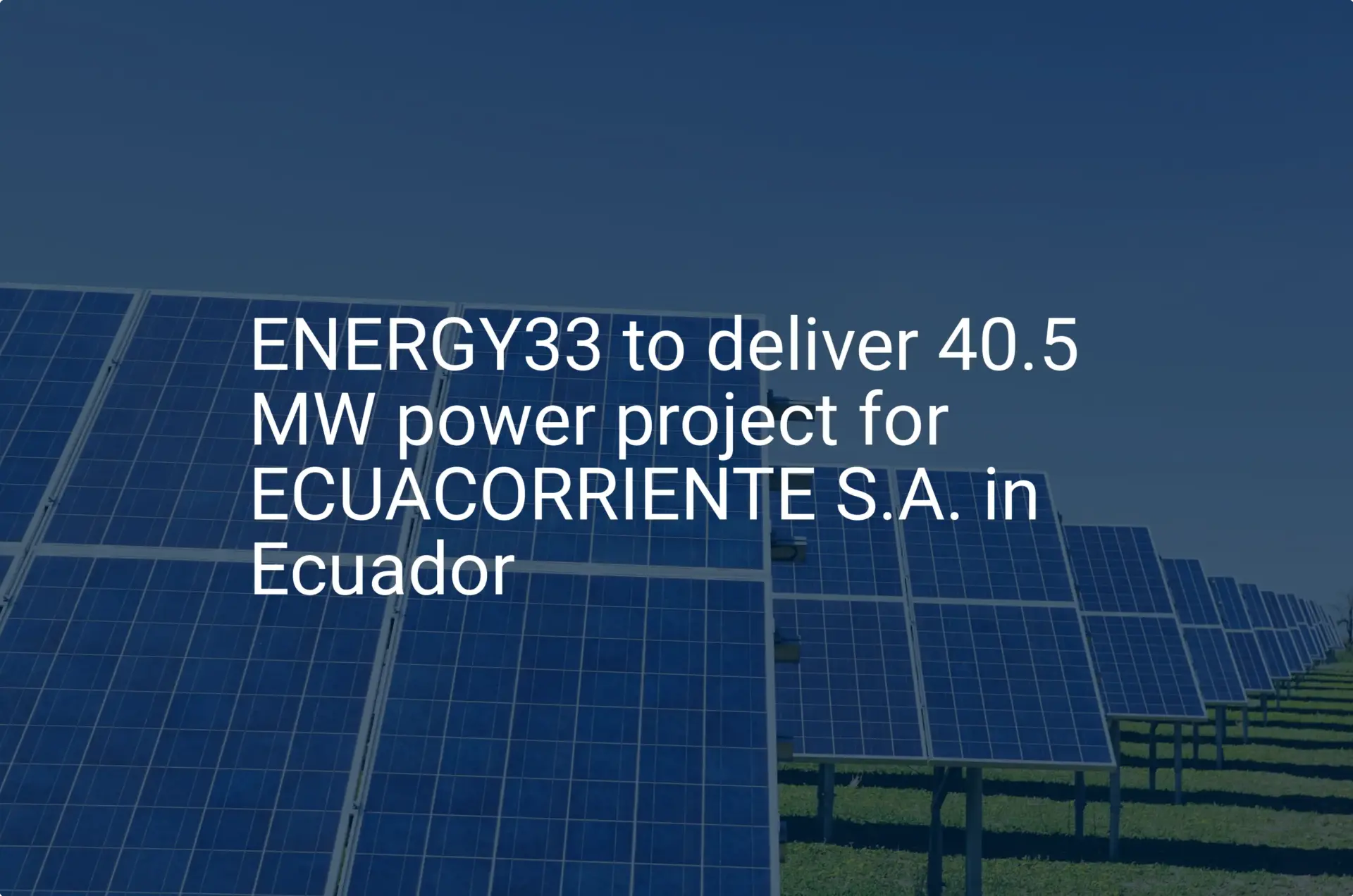An entrepreneur in Quito has finalized the business plan for a new solar module factory, secured funding, selected a building, and put an initial team in place. Now, one of the first and most critical operational questions arises: where to procure the raw materials? Is it more strategic to import established components from Asia, or can a resilient, local supply chain be built within Ecuador and its neighboring Andean Community countries?
This decision involves far more than a simple cost comparison. It shapes logistics, quality control, cash flow, and the long-term viability of the operation. This article examines the key considerations for sourcing critical materials like aluminum frames and tempered glass, comparing the well-trodden path of Asian imports with the strategic potential of the regional Andean market.
The Core Sourcing Dilemma: Local, Regional, or Global?
A solar module is an assembly of specialized components. While cells are almost exclusively sourced from Asia, several key bulk materials present a strategic choice for a new manufacturer, including aluminum frames, tempered solar glass, junction boxes, and backsheets. The article [What Raw Materials Are Needed to Manufacture Solar Panels?] details a complete list of these essential inputs.
For an enterprise in Ecuador, the sourcing decision for these materials boils down to three main geographical options:
- Local (Ecuador): Sourcing from domestic suppliers.
- Regional (Andean Community): Sourcing from partners in Colombia, Peru, or Bolivia.
- Global (Primarily Asia): Importing from the established global supply hub.
Each path comes with a unique set of opportunities and challenges related to cost, logistics, and quality assurance.
Evaluating the Andean Community Supply Chain
The Andean Community (CAN) is a trade bloc comprising Bolivia, Colombia, Ecuador, and Peru. A significant advantage of this pact is the elimination of tariffs on most goods traded between member countries, making regional sourcing an immediately attractive proposition. Tapping into the industrial capabilities of these neighboring nations can help build a more responsive and potentially cost-effective supply chain.

However, availability and quality require careful assessment. Let’s examine two of the most important components.
Aluminum Frames: A Test Case in Local Capability
Aluminum frames provide structural integrity to the solar module. While countries like Ecuador and Colombia have existing aluminum extrusion industries serving construction and other sectors, manufacturing frames for photovoltaic modules presents unique challenges.
Solar module frames are not standard architectural profiles. They require precise tolerances, specific alloy compositions for strength and corrosion resistance, and intricate designs to accommodate sealing, mounting, and grounding.

Based on experience from J.v.G. turnkey projects, developing local suppliers is possible but requires a dedicated effort. One project in Colombia, for instance, involved identifying a local aluminum extruder as a potential partner. Adapting their production to meet the stringent specifications for PV module frames required a six-month co-development period involving intensive technical consultation and quality control adjustments. The result was a reliable, tariff-free local supply chain that significantly reduced lead times and shipping costs.
Tempered Glass: Balancing Quality and Availability
The front glass of a solar module must be highly specialized. It needs to be low-iron tempered glass for maximum light transmission, cut to a precise thickness (typically 2.8 to 3.2 mm), and often finished with an anti-reflective (AR) coating to improve energy yield.
While glass manufacturers exist within the Andean region, few may have experience producing glass to these exact specifications. The critical question for a module manufacturer is whether a regional supplier can consistently meet the quality standards required for international certification. Any compromise on glass quality can lead to module failures, performance degradation, and failure to pass essential certifications detailed in [Understanding Solar Panel Certifications: What is IEC 61215?].
The Asian Import Alternative: A Well-Established Path
The alternative is to source components from Asia, the global hub of solar manufacturing. This path offers distinct advantages:
- Mature Industry: Suppliers have years of experience producing PV-specific components.
- High Volume & Low Cost: Economies of scale often result in a lower base price per unit.
- Certified Components: Most major suppliers already provide materials that meet IEC and other international standards.
However, this established route has its own drawbacks:
- Long Lead Times: Ocean freight from Asia to Ecuador can take 6-8 weeks, tying up capital and requiring larger inventories.
- High Logistics Costs: Shipping, insurance, and port fees add a significant percentage to the final cost.
- Import Tariffs: Unlike regional trade, imports from outside the Andean Community are subject to tariffs that can impact competitiveness.
- Geopolitical & Shipping Risks: The business is exposed to global shipping disruptions, currency fluctuations, and trade policy changes.

A Comparative Framework for Decision-Making
A strategic decision requires analyzing several factors beyond the supplier’s initial quote.
Cost Analysis: Beyond the Sticker Price
The most important metric is the landed cost—the total cost of a product when it arrives at the factory door.
Asian Imports: Landed Cost = Base Price + Sea Freight + Insurance + Port Fees + Import Tariffs + Inland Transport.
Regional Sourcing: Landed Cost = Base Price + Land Freight + Insurance + Inland Transport.
While the base price from an Asian supplier may be lower, eliminating tariffs and substantially reducing freight costs can make regional sourcing the more economical option overall.
Logistics and Lead Times
Shorter lead times from regional suppliers (1-2 weeks by land versus 6-8 weeks by sea) offer significant business advantages. They allow for a more agile, just-in-time inventory model, which reduces warehousing costs and improves cash flow. However, planners must also account for logistical challenges within the Andean region itself, such as mountainous terrain and variable road infrastructure, which can affect delivery reliability.
Quality Control and Certification
Quality control is arguably the most critical factor. Sourcing from established Asian suppliers offers greater assurance regarding quality and existing certifications. Developing a regional supplier requires the factory to invest heavily in its own quality assurance processes, including supplier audits, material testing, and potentially co-investing in production line upgrades. This initial effort is a key part of pursuing a local sourcing strategy, as covered in [A Step-by-Step Guide to Setting Up a Solar Panel Production Line].
Strategic Implications for a New Solar Enterprise
The choice between a regional and a global supply chain is a fundamental strategic decision.
Regional Sourcing Strategy
This approach prioritizes long-term resilience, shorter lead times, and potential cost advantages. It fosters local economic development and insulates the business from global shipping volatility but carries a higher initial risk and requires significant upfront investment in supplier development and quality assurance.
Global Sourcing Strategy
This path favors short-term reliability and access to proven, certified components. It is often faster to get started, as the supply chain is already mature. However, it exposes the business to long-term logistical risks, higher inventory costs, and the complexities of international trade.
Many successful ventures adopt a hybrid model, initially importing critical components from Asia while simultaneously working to develop regional suppliers for the long term.
Frequently Asked Questions (FAQ)
Is it cheaper to source from Asia or the Andean Community?
It depends entirely on the ‘landed cost.’ A lower per-unit price from Asia can be offset by high shipping costs and import tariffs. Regional sourcing, while potentially having a higher base price, often becomes more cost-effective once tariffs are removed and logistics costs are lower. A detailed calculation is necessary for each component.
Can a local aluminum extruder simply start making PV frames?
No. Standard aluminum profiles are very different from PV frames. A successful partnership requires a co-development process in which the module manufacturer provides technical specifications and the extruder adapts its processes for die design, alloy composition, and tolerance control. This often takes several months.
What is the biggest risk of sourcing regionally?
The primary risk is quality control. A new manufacturer must ensure that regional suppliers can consistently meet the stringent technical and quality requirements needed to pass international certifications like IEC 61215. This requires robust auditing and incoming material inspection processes.
How does the Andean Community (CAN) trade pact help?
The pact’s main benefit is the elimination of import tariffs on goods traded between member countries (Ecuador, Colombia, Peru, Bolivia). This provides a direct financial incentive to source from neighboring countries, making them more competitive against suppliers from Asia or Europe.
Conclusion: Building a Resilient Supply Chain
The decision of where to source raw materials for a new solar factory in Ecuador is complex, with no single correct answer. A strategy focused on importing from Asia offers speed and proven quality, while developing a regional supply chain within the Andean Community offers long-term resilience, cost control, and agility.
The optimal approach often involves a phased strategy: begin production with reliable components from established global suppliers while methodically identifying and developing local and regional partners. This undertaking requires deep technical expertise and a clear understanding of the trade-offs involved. Proper due diligence and expert guidance are essential to building a supply chain that is not only cost-effective but also resilient enough to support your factory’s growth for years to come.






